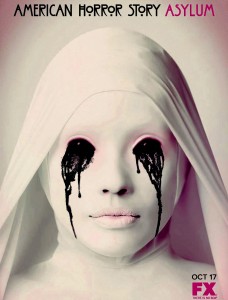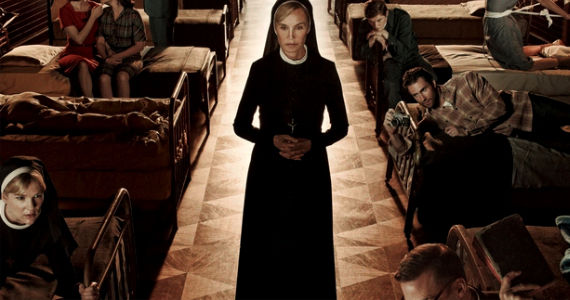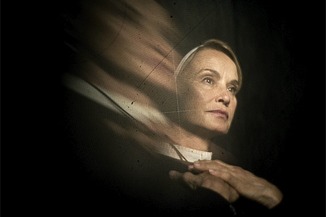TV Commentary: “American Horror Story” — The Homeland as Asylum?
American Horror Story: Asylum didn’t skimp on the scary; there’s enough disturbing images per episode to satisfy the most discriminating taste in horror.
By Keaton Goldsmith
Since the beginning of American Horror Story’s (AHS’s) second season, I’ve found it incredibly hard to fall asleep on Wednesday night. Brad Falchuk and Ryan Murphy have created two great seasons for FX that have successfully reinvigorated my nightmares. American Horror Story: Asylum didn’t skimp on the scary; there’s enough disturbing images per episode to satisfy the most discriminating taste in horror. Terrific performances by the likes of Jessica Lange and Zachary Quinto bring humanity and realism to the story. The latter of are premium value to AHS: Asylum, given that the plot often takes a turn toward the surreal and inhumane. The initial scare inevitably subsides, but viewers still have to grapple with the show’s unsettling and lingering primal suggestion — perhaps America is a place that eagerly breeds its own monsters. And now that the finale has aired and it looks like I’ll sleep again, it’s time to ponder that message.
A caveat to readers—Spoilers ahead.
In its first season, American Horror Story adopted and developed some of the essential themes of a modern, American horror tradition. The writers worked with the concepts that consistently terrify us in our daily life. Essentially, AHS: Murder House was a story about infidelity that ended up concerning school shootings, rape, and unwanted pregnancy.
While the second season took up a new plot with fresh themes, one element from AHS: Murder House remained. Both seasons capitalize on the fear of a tainted birth. But while the first season played around with the notion of an anti-Christ, AHS: Asylum developed the subject by way of slight political undertones.
The show is also completely fearless when it comes to engaging the topic of abortion. The story is predominantly set in the 1960s, inside a church-run asylum somewhere in Massachusetts. The horrifying image of Grace’s botched sterilization in the fifth episode was a visceral reminder of American Horror Story‘s determination to disturb, its obsessive circling around the hot button issues of castration and miscarriage, fertility and birth. Inevitably, it becomes a discussion about the ambiguity of birth, the DNA of destruction: Are serial killers born or made, and why do they keep showing up?
In AHS: Murder House, there was no confusion about the destiny of the strange twin sitting in Vivien Harmon’s womb — it’s most definitely the anti-Christ. It falls perfectly in line with the sordid history of a house that seems to churn with hyperbolic memories of aggression, infidelity, and miscarriage. Of course, Murder House would incubate the harbinger of the end of days. Still, AHS: Asylum plays around with the “origin of evil” conceit a little more fully. It brings up an uncomfortable question: are monsters made or born?
In an asylum as nefarious and deranged as Briarcliff, insanity is engendered by the cruel, draconian treatment of its keepers. Dr. Oliver Thredson (Zachary Quinto) gets an opportunity to tell his story in episode six, “The Origins of Monstrosity,” and it’s revealed that Bloody Face was born out of the doctor’s dark, alienating brooding over feelings of abandonment. The implication is that a monster like Bloody Face is a product of mistreatment and neglect at the hands of the system.
Thredson, like the residents of Briarcliff, was a ward of the state and entered society as a deeply flawed, rather than reformed, individual. When Lana Winters (Sarah Paulson) becomes pregnant with Thredson’s child, there’s a strong parallel to the plight of Vivien Harmon (Connie Britton) in the show’s first season. Is the baby in her womb really destined to be the heir to a legacy of violence and madness? As the story cuts back and forth between the past and present, we see the emergence of a new Bloody Face (Dylan McDermott). Evidently, Thredson was right: Lana’s neglect only served to bring another violent and confused being into the world.
All the same, there’s something to be said about the environment: Briarcliff, a deranged microcosm of institutional injustice, creates its fair share of monsters. In the lab of Dr. Arden (James Cromwell), people are turned into rasping abominations, and the regiment of corporeal punishment seems to generate insanity rather than curtail it. Characters, such as Lana and Sister Jude (Jessica Lange), are thrown into the asylum and find themselves transformed. Briarcliff inevitably breaks Jude — she loses the faith and moral conviction that’s kept her upright for years. Lana endures psychological, physical and sexual abuse at Briarcliff and in Thredson’s basement. While she doesn’t go through death and resurrection like some of the other characters on the show, her storyline still strikes me as strikingly intense and tortured. She’s not only abandoned and betrayed by her lover, but is subjected to every kind of cruelty. She escapes and seems to transcend the experience, yet finds herself drawn back towards Briarcliff.
Lana returns to expose the institution’s atrocities, but before the season finishes a confrontation with her past suggests the frightening change in Lana. Her experiences in Briarcliff nurtured a stony resolve to survive in her, and it’s for that reason that she unflinchingly shoots her son. A colder, determined Lana emerged from Briarcliff, replacing the one we knew.
During the finale, Lana tells her camera crew that with her exposé of Briarcliff she aims to “put America in the asylum” with her. The political resonance is obvious: American Horror Story delves into fantastic ways violence erupts in America, fusing the notion of “evil” as esoteric and the diabolic as the prosaic. In this way, its creators succeed in balancing entertainment with cutting cultural relevance. In a sense, they have seen America as an asylum by alluding to the genuine, multiple horrors to be found in the country’s past and present. Where will they take this discussion in their third season? I’ll probably be watching with the lights on.
Tagged: American Horror Story, American Horror Story: Asylum, Brad Falchuk, FX, Jessica Lange, Ryan Murphy



